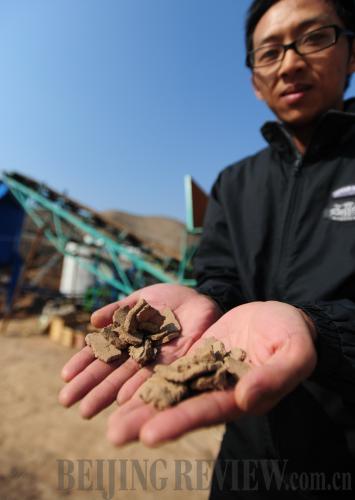 |
|
CURING THE SOIL: A technician shows treated soil at Minqin Village in Baiyin City, northwest China's Gansu Province, on October 16, 2011 (NIE JIANJIANG) |
In 2005, the Shanghai Academy of Environmental Sciences (SAES) established the Shanghai Center for Soil Remediation. Since then, the center has completed more than 20 major projects, including the World Expo Park, as well as several subway stations and residential compounds, which were being built on contaminated soil. More than 400,000 cubic meters of contaminated soil and 20,000 tons of underground water were treated.
The center is working on comprehensive remediation for the Shanghai Disneyland project in the city's Pudong New Area and the Nanda area development project in Baoshan District, which involves 1,000 factories being shut down over the next five years to make room for residential compounds.
"The World Expo project was the first large-scale soil remediation work in China. It showed that we have developed a feasible and effective method of soil remediation," said Li Yun, Director of the Marketing Department of the SAES. She led the team that drafted the standards for evaluating the soil remediation at the World Expo Park.
In this particular zone, where a steel manufacturing factory stood, the soil was largely contaminated by heavy metals and POPs.
Li said her team used advanced solidification-stabilization technology to remove the heavy metals from the soil and bio-pile technology to clean POPs. "The remediation proved very successful," Li said.
The standards drafted by Li's team were later submitted to the Ministry of Environmental Protection and officially published as the country's first remediation standards in the Standard of Soil Quality Assessment for Exhibition Sites published in 2007.
Statistics released by hjxf.net showed that more than 20 new land remediation companies were registered in China in 2011.
During an environmental industry forum held on March 20-21 in Beijing, Gao with hjxf.net predicted that the market value of soil remediation in China would be as high as 40 billion yuan ($6.35 billion) by 2015. "The urbanization rate in China is only about 50 percent. Therefore, 40 billion yuan is just a rough estimate," he said.
According to the World Bank report, in China, most soil remediation projects cost more than 100 million yuan ($15.87 million) each.
In 2009, southwest China's Chongqing spent 800 million yuan ($126.98 million) assessing the contamination of 45 lots of land, and the cost of cleaning up the land is expected to exceed 2 billion yuan ($317.38 million).
Last year in Beijing, a massive remediation project cost more than 700 million yuan ($111.11 million), the most that has been spent on single remediation project in China.
Given its breakneck growth, more money is flowing in. At the end of 2011, Sequoia Capital, a U.S. venture capital firm based in California, invested in a Beijing-based environmental remediation company secretly, said the Guangzhou-based Southern Weekend.
On February 21, BCEG Environmental Remediation Co. Ltd., a wholly owned subsidiary of Beijing Construction Engineering Group, announced its bid to go public. The company said on its website that it had undertaken 80 percent of soil remediation projects in China.
Meanwhile, China's heavy demand for soil remediation has also created a lot of work for many research institutes of environmental sciences, which assess pollution levels and work out detoxification programs.
| 